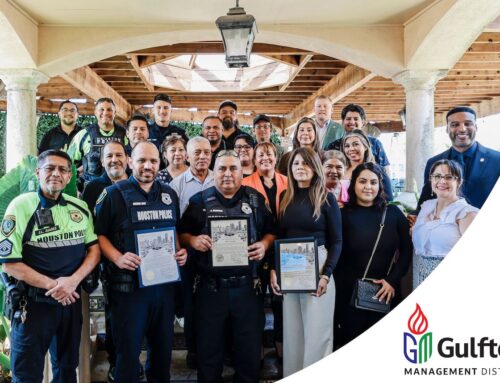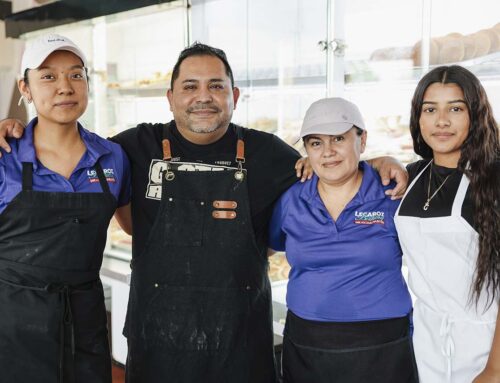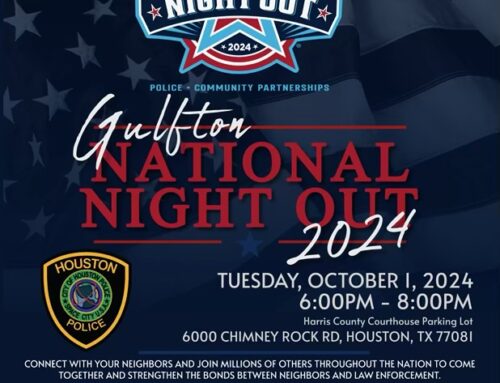How does an artist capture the vibrance and style of Gulfton in a painting the size of a three-story building, complete the job in three days, and keep his car from being towed away by mistake?
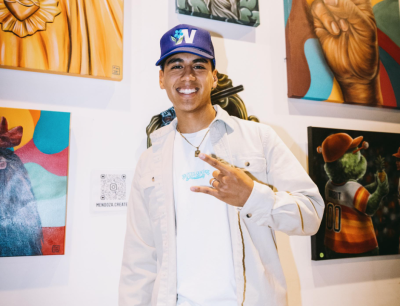
Mendoza
Floyd Mendoza, 25, a rising star among Houston’s talented corps of street artists and muralists, pulled it off.
His dramatic work of art on a wall at the Alora Apartments, 5500 El Camino Del Rey St., is in full view from Houston’s Westpark Tollway.
The work, entitled ‘The Flora of Gulfton,’ is a dramatic abstract mural, rich in colors and symbolism, that showcases flowers from the Americas, Africa, Europe and Asia – the ancestral homes of Gulfton’s diverse community.
Although it took Mendoza only three days to finish the project, he would be the first to admit that it required “a village” of committed people to plan and pull it off.
The preparation for The Flora of Gulfton – a partnership among Mendoza, UP Art Studio, and the Gulfton Area Management District – was completed in May but took many months of advanced planning to get to the finish line.
This is how an urban mural comes to life from start to finish:
Months of planning
Mendoza was chosen for the project by a Houston consulting firm owned by Elia and Noah Quiles that initiates art projects in urban communities.
Finding the canvas
For a decade, UP Art Studio has been holding events called “Big Walls Big Dreams’’ in Miami and Houston with the goal of finding participants to place fine art on outdoor cityscapes.
With the support of the Gulfton Area Management District, UP Art Studio landed the wall on the Alora Apartments.
“Acquiring the site can be the most difficult part of the project,” Elia Quiles said.
Selecting the artist
UP Art has collaborated with many talented muralists on works throughout Houston but Mendoza was a natural for this one because of his talent, personality and technical skills. He had completed three other murals for UP Art.
“Floyd is young, he is eager and he is talented,” said Noah Quiles. “We thought he (a young Hispanic) was a good fit demographically for the neighborhood as well.”
Choosing the theme
Deciding on the subject of the mural involved give and take between Mendoza, UP Art and the Gulfton community.
In choosing a theme, it is not always the first idea that is chosen, Mendoza said. “But if the first idea doesn’t work, try again.”
For The Flora of Gulfton, he submitted a sketch with portraits of different people he knew. But when some community members suggested that flowers would have a broader appeal, all parties were onboard.
“As a street artist, when you put art on the side of a building, it is not your work, it is for the community and the people who live there, Mendoza said. “You have to see it from that perspective.”
Presenting the design
Mendoza then chose the flowers and presented the image as a web design. “I picked each flower,” he said.
Today’s street artists can use a sketch pad or a computer screen to create the model design for their giant creations. Mendoza uses the Procreate app, which he said is a useful and convenient tool for creating the initial rendering.
The flowers – beauty and meaning
The flowers – the Tulip, Calla Lilly, White Ginger, Flor de Izote and White Garland — were chosen for their beauty and countries of origin to represent the Gulfton neighborhood’s unique character and heritage.
The tulip, one of the world’s most recognizable flowers, is associated with the Netherlands but is also native to Afghanistan, Iran and Turkey.
The dahlia, a source of food and medicine as well as a favorite ornamental display, is native to Mexico.
The calla lily, a native of South Africa, has also adapted well to the highlands of Mexico and is found in many flower markets there.
The flor de izote, or yucca flower, the national flower of El Salvador, is used in the textile process, production of alcohol and the blending and flavoring of Salvadoran and Mexican food.
The white ginger lily is a native of Asia, including India, Thailand and China. It is also the national flower of Cuba where, during Spanish colonial times, women adorned themselves with it and carried within it secret messages related to the fight for independence.
“We incorporated those flowers and used a simple style to represent the community, “Mendoza said. “The message is that that we are all the same even if we are different.”
Gathering materials and equipment
Artists who paint on the sides of buildings need ladders, scaffolds and lift trucks and they buy their paint by the gallon. Once the paint is selected, blending the right colors is critical.
Time to go up on the wall
Day One
When Noah Quiles showed up at the site the first morning to give his artist final instructions and a safety briefing, Mendoza was already there and ready to start.
“I told him to mind his Ps and Qs and to avoid dropping paint on the cars of any of the residents and then I got out of his way,” Quiles said.
Mendoza began painting around around 9 a.m. with the good light and he planned to work until 6 p.m.
Then came the rain.
A brief shower on his first day was not a big problem, Mendoza said.
“I’m used to that but I actually did think it would take longer than three days to complete the job when I started. But once you get in the groove it is kind of hard to stop.”
Following the design he created on his iPad, Mendoza first applied the background ‘filler’ colors from gallon containers of latex paint. Then He put doodle figures such as smiley faces on the wall to create a grid
that he used to judge the precise dimensions and locations of each shape.
Working in his favored ‘zig zag’ style, he used aerosol spray paint cans with special applicator caps to shape and draw the finer details in the work.
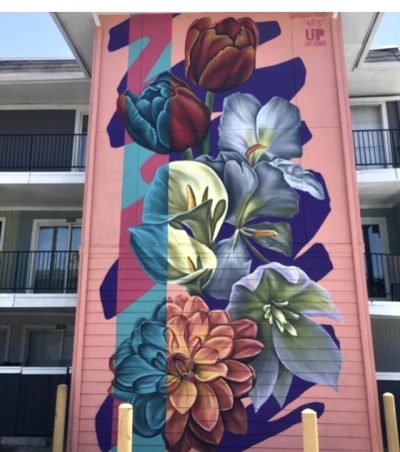
Finished product
Day two
The first two days working on a mural are the most crucial to any big project like this, Mendoza said.
The second day was free of rain, just hot and humid.
Mendoza’s plan was to work through the day and take a break only if he got really hungry.
“I was moving at a good pace and I just kept painting.”
This is the day when Mendoza peered down from his platform on the lift truck and saw his car being towed from the parking lot.
He had informed the apartment manager that every space appeared to be a reserved spot but the manager said using one would not be a problem.
It became a big problem.
“The truck was taking my car off and I have all my paint in it,” Mendoza said. “I chased it all the way to the front of the building and I told the guy I needed it for my work. He dumped my car in the middle of the street. He was very rude about it but it was funny.”
Day three
Mendoza finished painting the work by early afternoon on the third day.
He’d used about two gallons of latex paint in blue and peach colors and 20 cans of spray paint to complete the mural.
When Noah Quiles showed up on day three to check on the work, all that was left to do was have a photographer arrive and take pictures.
“He completed the job in breakneck speed,” Quiles said. “I said wonderful, high-fived the artist and told him to send the invoice.”
— By Phil Shook

